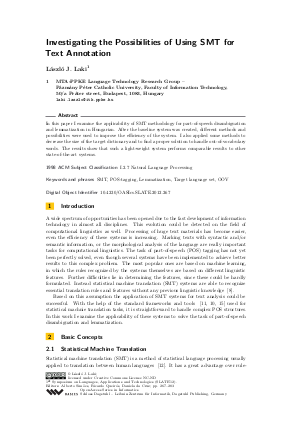Investigating the Possibilities of Using SMT for Text Annotation
Author László Laki
-
Part of:
Volume:
1st Symposium on Languages, Applications and Technologies (SLATE 2012)
Part of: Series: Open Access Series in Informatics (OASIcs)
Part of: Conference: Symposium on Languages, Applications and Technologies (SLATE) - License:
 Creative Commons Attribution-NonCommercial-NoDerivs 3.0 Unported license
Creative Commons Attribution-NonCommercial-NoDerivs 3.0 Unported license
- Publication Date: 2012-06-21
File

PDF
OASIcs.SLATE.2012.267.pdf
- Filesize: 0.54 MB
- 17 pages
Document Identifiers
Subject Classification
Keywords
- SMT
- POS-tagging
- Lemmatization
- Target language set
- OOV
Metrics
- Access Statistics
-
Total Accesses (updated on a weekly basis)
0PDF Downloads0Metadata Views
Abstract
In this paper I examine the applicability of SMT methodology for part-of-speech disambiguation and lemmatization in Hungarian. After the baseline system was created, different methods and possibilities were used to improve the efficiency of the system. I also applied some methods to decrease the size of the target dictionary and to find a proper solution to handle out-of-vocabulary words. The results show that such a light-weight system performs comparable results to other state-of-the-art systems.
Cite As Get BibTex
László Laki. Investigating the Possibilities of Using SMT for Text Annotation. In 1st Symposium on Languages, Applications and Technologies. Open Access Series in Informatics (OASIcs), Volume 21, pp. 267-283, Schloss Dagstuhl – Leibniz-Zentrum für Informatik (2012)
https://doi.org/10.4230/OASIcs.SLATE.2012.267
BibTex
@InProceedings{laki:OASIcs.SLATE.2012.267,
author = {Laki, L\'{a}szl\'{o}},
title = {{Investigating the Possibilities of Using SMT for Text Annotation}},
booktitle = {1st Symposium on Languages, Applications and Technologies},
pages = {267--283},
series = {Open Access Series in Informatics (OASIcs)},
ISBN = {978-3-939897-40-8},
ISSN = {2190-6807},
year = {2012},
volume = {21},
editor = {Sim\~{o}es, Alberto and Queir\'{o}s, Ricardo and da Cruz, Daniela},
publisher = {Schloss Dagstuhl -- Leibniz-Zentrum f{\"u}r Informatik},
address = {Dagstuhl, Germany},
URL = {https://drops.dagstuhl.de/entities/document/10.4230/OASIcs.SLATE.2012.267},
URN = {urn:nbn:de:0030-drops-35285},
doi = {10.4230/OASIcs.SLATE.2012.267},
annote = {Keywords: SMT, POS-tagging, Lemmatization, Target language set, OOV}
}
